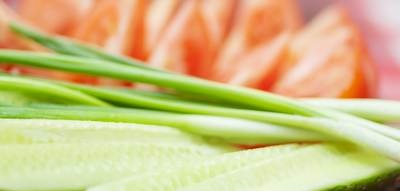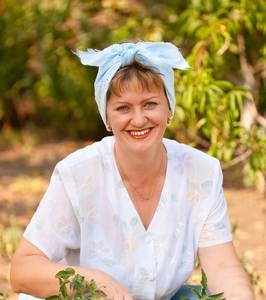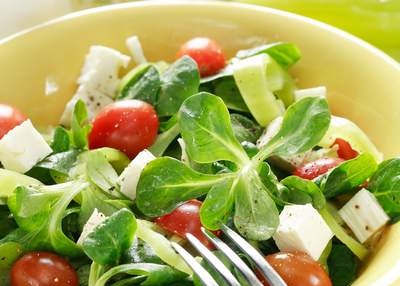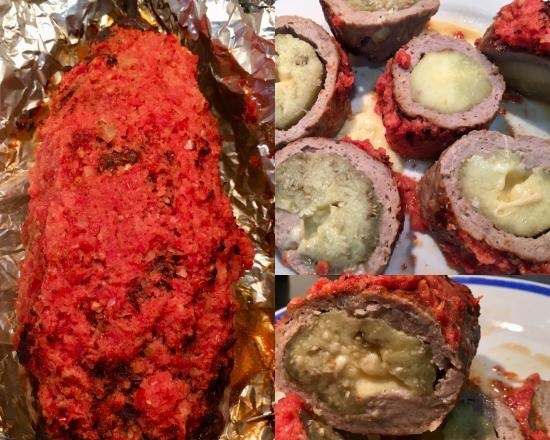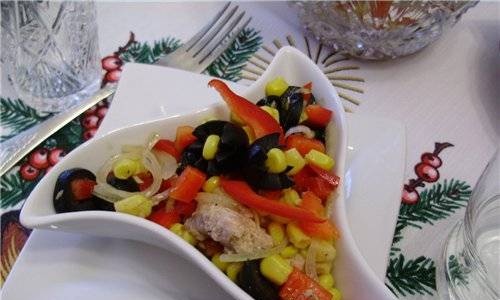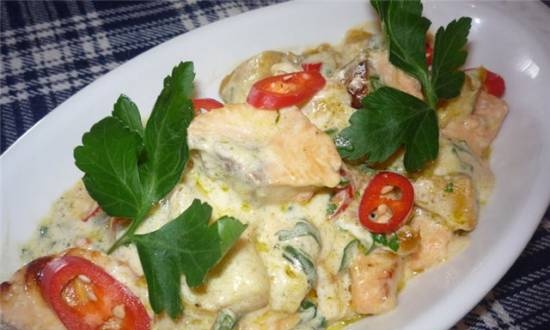|
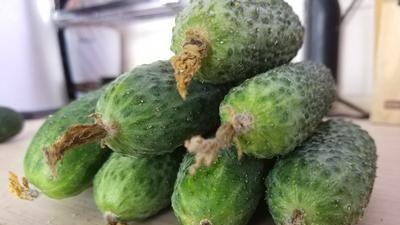 Vegetarians don't eat meat. They don't drink milk either. In general, they do not recognize any animal food. The menu is only vegetable. They think it's healthier this way. Vegetarians don't eat meat. They don't drink milk either. In general, they do not recognize any animal food. The menu is only vegetable. They think it's healthier this way.
Their opponents are sure that there is no harm from meat (in moderate doses, of course). In general, there is a lot of controversy. One thing is clear: the benefits of plant foods are great, even with or without meat. And since vegetables are the basis of a vegetarian diet, medicine is paying more and more attention to them.
Let's remember what we eat every day. Cabbage, carrots, onions, cucumbers, tomatoes. Add here more garlic, dill, parsley, celery... Previously, turnips were still in vogue. The arsenal of vegetables is increasing every year. In addition to cabbage and cauliflower, we already eat kohlrabi and Brussels sprouts. Forgotten non-letting radishes and green radishes appeared. More often they began to put pumpkin and especially greens on the table: watercress, regular salad and aromatic cilantro.
However, neither the buyer nor the seller often knows what they are buying and selling. There is a pumpkin on the counter: gray, green, red. What kind? Unknown. What kind of cucumbers? And who knows. Recently, plum-shaped small tomatoes have become fashionable. And almost no one will name these! But each variety has its own characteristics. Your own taste. Your soil requirements.
If you do not know them, then you can make as many mistakes as there were in due time with our old companions - turnips and cucumbers. You can harm your health if you eat such common vegetables as cabbage and carrots without knowledge. Vegetarian food is good if you understand it correctly.
Here is the punishment! Such a cute, juicy, crispy, aromatic and ... bitter! The whole harmonious harmony of taste perfection of the green fruit is completely crossed out by bitterness. And the half-eaten masterpiece flies into the trash. What can you do? Bitterness is not only a privilege of cucumbers. There are bitter melons and pumpkins. The colocynth, a relative of the watermelon, is unbearably bitter. And a distant relative of the cultivated cucumber kukumis hardwick from the Indian jungle.
They tried to get rid of bitterness for a long time. They were looking for a reason. Called different. And most often the lack of water. If the cucumbers are watered a little, the fruits begin to taste bitter. However, on the same whip with the same watering, both bitter and sweet ones turn out to be. Finally, we paid attention to the varieties. We sifted through everything and, to the general joy, found that there is a variety with absolutely no bitterness - the local Klin. He was brought out by the gardeners of the town of Klin near Moscow.
And although the variety was found, the cause of the bitterness was not found. Professor V. Edelstein took up the search for it in a serious way. What did he not do! At the vegetable station of the Timiryazev Academy in Moscow, cucumbers were grown on different soil: clay and sandy, on pure humus and low-lying peat. They gave different watering. Shaded and not shaded. And every time the sweet fruits were accompanied by bitter ones. Like a fly in the ointment in a barrel of honey.
 In particular, the professors were attracted by the Klin cucumbers. This is a greenhouse variety. In March - April, there really were no bitter fruits in the greenhouses. However, since May, when the sun shone at full power, the Klin variety behaved like everyone else. His hopes were dashed. True, we managed to notice an interesting fact. Protecting the plants from the excess of May rays, the greenhouse roof was whitened. And the bitterness was gone. But in the fields, no one protects the whip from the sun, and not all greens are bitter. In particular, the professors were attracted by the Klin cucumbers. This is a greenhouse variety. In March - April, there really were no bitter fruits in the greenhouses. However, since May, when the sun shone at full power, the Klin variety behaved like everyone else. His hopes were dashed. True, we managed to notice an interesting fact. Protecting the plants from the excess of May rays, the greenhouse roof was whitened. And the bitterness was gone. But in the fields, no one protects the whip from the sun, and not all greens are bitter.
Edelstein was not alone in working on the problem of bitterness. In the early 1960s, the University of Washington received many requests. A consultation was convened: who can name the reason? Nobody. We decided to find out empirically. The teachers armed themselves with knives: they cleaned, cut, ate. They exterminated a lot of zelents - several hundred. Finally, they drew cross-sections of the fruit and began to explain.
It's all about the skin.The further from it into the depths of the fruit, the less bitterness. Peel the greens without sparing the pulp. Whoever regrets will lose. You can even cut off all the pulp - this is a win-win option. There is no bitterness in the seed chambers. Second conclusion: it is also important how to clean, from which end. If from a tail, then all the bitterness will spread over the fruit. Hence, it is necessary, on the contrary, to the tail. In general, these experiments did not yield much.
There was hope for the varieties. And just recently, the world learned that Belgian gardeners brought cucumbers out of Africa without any bitterness. They were crossed with European ones and finally got sweet-fruited hybrids. But who can guarantee that the same opportunity will not happen to them as to the Klin hothouse? And the reason for the bitterness remained unclear. It is believed that cucurbitacin, which causes bitterness, accumulates when fetal growth is inhibited, whether from light, dryness, or cold.
Born in the tropics, our hero was created for a long growing season. His whips can stretch into the distance almost indefinitely. However, in our conditions, in the Moscow region, varieties of the opposite quality have success: with a short growth period. And with short lashes. The plants are early maturing. The earliest of them is the Murom cucumber. From germination to harvest - five weeks! Of course, this speed comes at a price. We lose in the size of the fetus. It is only 6 or 8 centimeters long. A little more than a chicken egg. And the shape is about the same. But it is delicious. It was created by gardeners from the city of Murom near Vladimir in ancient times. Experts praised Murom as best they could. And it is elastic and fragrant. And the skin is thin, like a tomato. And water in moderation. And you will not find better for salting. Moreover, it is extraordinarily prolific. All in all, the ideal type of cucumber! No flaws.
Of course they overrated. There are drawbacks. It's too small. It turns yellow quickly. And most importantly, it does not work well in inclement weather. Near Moscow, in bad weather, Murom completely disappeared, and then the market was empty.
And suddenly everything changed. The rainy, cold autumn was coming, and the market was full of cucumbers. Muscovites were surprised. But the goods were on the shelves - delicious, green. And even larger than usual.
- More rains - better filling, - explained the gardeners.
- Something now they do not turn yellow with you? - the buyer wondered.
Resourceful sellers did not go into their pockets for a word.
- Why should they turn yellow? Probably not a drought.
Joyful Muscovites hurry home. Greenery is salted with cans of dill and currant leaves. Winter is approaching, and here the incomprehensible is revealed. Instead of the usual crispy cucumber, the jar turns out to be something completely different. Empty inside, the taste is rough and the smell is disgusting.
It turns out that it was not the Murom people who bought it, but a new German variety called Pride of the Market. We call them Unbearable because they do not lose sight in bad weather and under cold dew.
However, for such persistence, the variety has lost other good qualities, has become empty, rough and completely unsuitable for salt. His skin is thick, the brine is difficult to penetrate inside. When fermentation begins, the gases from the inside also do not come out. In addition, the seeds are also too large. Muscovites from that memorable year began to look closely at the goods and found a way to distinguish the Pride of the market from all others. The dark green bark of the Unwearable gleams like steel. There is no such plaque in other varieties.
Observing the truth, it must be said that the most delicious cucumbers are still not Murom, but Nezhinsky. They have the most attractive view. Triangular shape. Dark green. Striped like a watermelon. And most importantly, all are covered with large warty tubercles. The size is twice the size of the Murom. The pulp is crispy, very tender, juicier than all other varieties.
When the Nezhinsky cucumber was brought to Moscow, Moscow gardeners decided to grow it at home. It grew well, but it was no longer as tasty as in Nizhyn. Of course, Moscow is not Ukraine, the climate is harsh, but Ukrainians also complained. They also fail to find Nezhin unique anywhere, except for Nezhin himself.Growing grows, but the quality is not the same. It seems that in Ukraine the climate is the same, mild, and black soil is everywhere ... Nevertheless, we decided to check the black soil and found out that it is special near Nizhyn. Very deep, glandular, and even strongly saline! This is exactly what the Nezhinsky masterpiece requires. It is salted not with ordinary water, but with Nezhinsky. It is taken from special springs. It is tough, ferruginous-limestone.
There is also another very interesting variety of cucumber - Margelan, from Central Asia. In Moscow, on the market at the height of summer, you may not even notice, but on the outskirts of summer, closer to spring or autumn, it stands out clearly among the mass of greenhouse, lanky greenhouses. It is completely cylindrical in shape and most of all resembles a sausage. Also sharply rounded at the ends. The skin color is dark green, with a slightly noticeable noble yellowness. The connoisseur will immediately highlight the Margelan cucumber by the skin and, without even knowing the variety, will say that it is from Central Asia. It is very easy to find out. The skin is shiny, completely smooth, without any stripes and pimples. And without the rough spines so characteristic of cucumbers. In hot and dry areas, the spines will only interfere, evaporating excess moisture, for which they were created. But the shiny, even skin is an ideal mirror for reflecting the sun's rays. The flesh of the margelanian is tender, as if melting in the mouth, and the seeds are barely felt.
So, another type of "perfect" cucumber? No, this creature also has flaws. He salts badly. Greens with spines are good for solka. The spines break, and the brine penetrates well at the fracture site. Margelan does not have such opportunities.
Until now, many people consider cucumber a vegetable, although delicious, but from a nutritional point of view, in general, useless. What's the use of it? Almost no calories. Vitamins for a penny. One water ... To which Professor V. Edelyitein always objected with indignation: "Water, but not tap!" Edelstein headed the Department of Vegetable Growing at the Timiryazev Agricultural Academy and knew about cucumbers. The first to be convinced of the correctness of his words, it seems, were doctors. Cucumber water is recognized by medicine and cosmetics as not the last thing. It refreshes the skin, removes freckles, makes the complexion healthier ... True, the reasons for all the rejuvenating transformations are not yet completely clear, but the fact itself is obvious.
Later it turned out that the cucumber refreshes not only the skin, but also cleanses the entire body. Firstly, an enzyme close to insulin was found in it. It increases the digestibility of animal products. It is not for nothing that a piece of cucumber is so requested for meat and fish. Secondly, cucumber is rich in alkaline elements. They act as a counterweight to acidic waste products in the intestines. But we love so much both bread and meat, and eggs. Without cucumber, acidic decomposition products are difficult to neutralize ... Besides, cucumber perfectly removes uric acid and water from the body. Thus, it regulates the functioning of the kidneys and heart. In ancient times, Greek doctors prescribed cucumber juice for all kinds of diseases with high fever. Modern Greek doctors also prescribe. And at high temperatures. And with neurasthenia.
 And it's good that a cucumber can be obtained these days at any time of the year. True, the path to this abundance was thorny and difficult. The pioneers were the Klin gardeners. Their skill was unsurpassed. Prominent scientists turned to them for help. Here is what the classic of agronomy Professor A. Doyarenko told about this. When the department of vegetable growing was opened in Timiryazevka, they immediately built a greenhouse and began to grow cucumbers. The longest whips grew, but no fruit was obtained. The scientists fought for two years, and finally went to Klin for advice. Klin gardeners managed to get from one square meter not 40 zelents, as usual, but 200 pieces! And this is with a cloudy winter sky. And it's good that a cucumber can be obtained these days at any time of the year. True, the path to this abundance was thorny and difficult. The pioneers were the Klin gardeners. Their skill was unsurpassed. Prominent scientists turned to them for help. Here is what the classic of agronomy Professor A. Doyarenko told about this. When the department of vegetable growing was opened in Timiryazevka, they immediately built a greenhouse and began to grow cucumbers. The longest whips grew, but no fruit was obtained. The scientists fought for two years, and finally went to Klin for advice. Klin gardeners managed to get from one square meter not 40 zelents, as usual, but 200 pieces! And this is with a cloudy winter sky.
The Klinsky craftsman came to Timiryazevka and demanded only one thing: a barrel of slurry. He put the barrel in the greenhouse, and there were noticeably more cucumbers. He taught Timiryazevs another technique. Smoked.As soon as the first leaves appear on the lashes, they close the chimney in the greenhouse and let the waste go. Entry is prohibited for two days and two nights. After carbon monoxide treatment, the number of female flowers increases. The harvest arrives in half and three times.
Now special varieties have been created with a lot of female flowers, but before that smoking helped out. The only thing that the Klin gardeners have made a mistake is in deforestation. The stoves in the greenhouses were heated with wood, which is why the surrounding forests were stripped 60 miles around the city of Klin.
True, there were also opposite examples, when cucumber fans took into account the saving mode. In Holland, for example, a variety of cucumbers was developed that can be grown at home on windows. But perhaps the most original solution to the cucumber problem was found by Professor V. Edelyitein. At one time, he adapted for the beds ... the roof of Moscow University!
Somewhat earlier, in 1911, the St. Petersburg gardener P. Dmitriev proposed to abandon greenhouses. In winter, he believed that fresh greens could be obtained in a completely different way. On his advice, cabbage seedlings and cucumbers are planted nearby. As soon as the forks begin to tie, a young green plant is pushed into them. The fork grows in size and turns into a mature head of cabbage. Here it is pulled out together with the poker and hung in a cool room. Store until spring. When the need arises, the forks are cut and a fresh, fragrant cucumber is extracted. As if fresh from the ridge. The only sin is the color is not green, but whitish. This is no wonder - he grew up in the dark!
So, the union with cabbage turned out to be beneficial. The union with the pumpkin is no less useful. Greenhouse figures have thought of it. Often in the greenhouse, the whips rot from root rot. It is especially difficult for the British. Their crops do not ripen on the ridges. All products are grown only under glass. In this situation, they began to graft seedlings on fig-leaved pumpkin. The same is done in Germany and Holland. And in Bulgaria they found that the figurative spoils the taste of the green a little. Much better - on a loofah, the one that gives a bath sponge.
And one more problem that has not yet been resolved. About the effect of moonlight on our charge. It's hard to say who first came up with the idea of associating cucumbers with moonlight, but many still believe that these vegetables grow well only on clear moonlit nights. At the beginning of this century, the Department of Agriculture publicly declared: all this is nonsense. Such a weak, so thin moonlight - how can it spur vegetables to grow? And the newspaper "Khutoryanin" in 1916 confirmed: the moon has nothing to do with cucumbers.
At one time, agronomists made fun of scientists who argued that cucumbers grow only at night, and then it turned out that this is really a fact. In March, when day is equal to night, millimeters grow by three or four per day, and three times more per night. But there are also moon nights?
And finally, about "hooks", about those crooked, bent, ugly greens that appear most often in the fall. Why are they? Because not all ovules are fertilized and, in connection with this, part of the seeds does not ripen. It depends on bad weather in the fall. But there are hooks in the summer, and then bees can be the fault. Or rather, the lack of bees. If there are enough bees, if there are one hive per hectare, then there are no freaks in the field. And in the beehives excellent cucumber honey is accumulated - 30 kilograms per hectare. In greenhouses - half as much.
A. Smirnov. Tops and roots
|
 Vegetarians don't eat meat. They don't drink milk either. In general, they do not recognize any animal food. The menu is only vegetable. They think it's healthier this way.
Vegetarians don't eat meat. They don't drink milk either. In general, they do not recognize any animal food. The menu is only vegetable. They think it's healthier this way. In particular, the professors were attracted by the Klin cucumbers. This is a greenhouse variety. In March - April, there really were no bitter fruits in the greenhouses. However, since May, when the sun shone at full power, the Klin variety behaved like everyone else. His hopes were dashed. True, we managed to notice an interesting fact. Protecting the plants from the excess of May rays, the greenhouse roof was whitened. And the bitterness was gone. But in the fields, no one protects the whip from the sun, and not all greens are bitter.
In particular, the professors were attracted by the Klin cucumbers. This is a greenhouse variety. In March - April, there really were no bitter fruits in the greenhouses. However, since May, when the sun shone at full power, the Klin variety behaved like everyone else. His hopes were dashed. True, we managed to notice an interesting fact. Protecting the plants from the excess of May rays, the greenhouse roof was whitened. And the bitterness was gone. But in the fields, no one protects the whip from the sun, and not all greens are bitter.




















